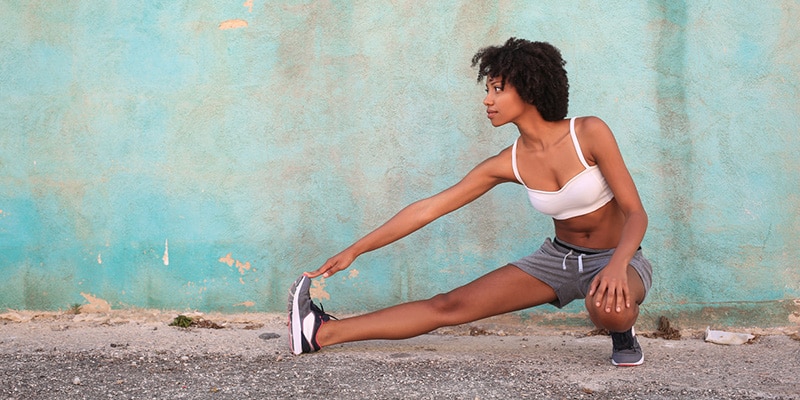Tips for Improving Your Flexibility for Those Who Hate to Stretch

So you hate stretching. You might say it’s boring, it’s uncomfortable, it’s time-consuming, or even all of the above. You think that being able to touch your toes is a farfetched fantasy. But did you know that a properly flexible muscle has 25% greater strength potential because it’s able to go through full range of motion?
Not only does proper flexibility increase your strength potential, it is also crucial for preventing injuries and having a better posture. According to Men’s Health, improving your flexibility and range of motion can add mass and length to your muscles, allowing you to generate more force and lift more weight. And ultimately, of course, that leads to bigger muscle gains.
Since flexibility is not something that makes a major difference on the way your body looks from the outside, many people skip this part of their fitness routine. However, the reward of stretching and improving your flexibility comes from how your body feels. Chalene Johnson, celebrity fitness trainer, explains that “Flexibility training will help you feel more fluid in your movements, it can decrease daily aches and pains, and proper flexibility sets the body up for greater force production.”
If you’ve ever struggled with flexibility training in the past, frustrated by relentlessly attempting to touch your toes to no avail, we’re here to help. Below we’ve outlined the best tips for improving your flexibility for those who hate to stretch.
Static vs. Dynamic stretching

Did you know that there are two types of stretching? You may understand stretching to consist of holding various uncomfortable positions for what seems like endless amounts of time. Those are static stretches, which are designed to hold a position for a joint or a muscle that is minimally challenging. The focus is on relaxing the body part being stretched and letting it go further on its own.
Then there’s dynamic stretching, which some may consider less tortuous than holding static poses. Dynamic stretches are designed to take a joint or a muscle through a challenging and repetitive motion, moving a body part further with each repetition. Dynamic stretching is ideal prior to exercise to prepare the joints and muscles for more challenging movements, thus increasing your “active” flexibility.
If you hate to stretch because holding one position for a set amount of time can be boring or uncomfortable, you might find that dynamic stretching is a better fit for you. An example of dynamic stretching is PiYo, which not only increases the body’s dynamic flexibility but also builds strength. Other examples include jumping jacks, arm circles, and high knees. Incorporating dynamic stretches into your fitness routine is one way to begin improving your flexibility.
Stretch every day
It’s easy to become discouraged with stretching, especially since it’s difficult to measure results and progress is typically slow. Even if you’re stretching consistently it can take weeks or even months to see and feel results. In order to start improving your flexibility, it’s recommended to stretch at least 10 minutes every day. If you stretch less frequently it’s possible to lose any gains you have made in your flexibility.
Unlike other forms of exercise, it’s not necessary to gear up and dedicate lengthy amounts of time to fit in a proper stretching routine. You can stretch at any time, such as while you’re cooking dinner, watching TV, or even during your lunch break at work.
Use proper stretching technique
No matter what type of stretching you choose to perform, always ensure you are using proper stretching technique. First, your stretch should always be pain-free. There’s a difference between the mild discomfort felt from stretching a muscle and being in pain. If you feel pain as you stretch, you’ve gone too far. Return to the point where you did not feel any pain and hold your stretch there. Also, always relax and breathe freely while you stretch.
Another part of proper stretching technique is to make sure you don’t bounce. Bouncing will stretch your muscles too far and too fast, which can result in a pulled muscle. Finally, use these proper stretching techniques on both sides of your body. This will ensure your joint range of motion is as equal as possible on each side of your body.
Focus on your stiffest areas
During your daily stretching, focus on your stiffest areas first. Whether that be tight hips, tight hamstrings, or tight shoulders, choose 2 to 3 stretches to increase that area’s range of motion. Narrowing your focus and committing to stretching every day is going to make a big impact on improving your flexibility.
Create specific targets to track your progress

Tracking your progress is a great way to stay motivated, especially for those who hate to stretch. Whichever area is your primary focus for improving your flexibility, create specific targets so that you can track your progress. For example, if you want to be able to lean over and touch the ground, start by measuring the point where your fingertips can touch your legs. Then, as time goes on, your fingertips might be able to touch your ankles. Soon your fingertips will touch the ground, and then your knuckles. And before you know it you’ll be able to lay your hands flat on the floor with straight legs!
Be patient
Even if you are stretching every day, don’t expect to wake up one morning and be able to do a split like Gabby Douglas. As mentioned above, improving your flexibility can take time, which means patience is key. Rushing your flexibility training will result in injuries rather than speeding your results.
Overall, know that improving your flexibility takes time. Try not to be discouraged if you haven’t made the progress you want in the past. Begin using some of the tips described in this article and you’ll start to notice improvements in your flexibility. Even those who hate to stretch!



1 thought on “Tips for Improving Your Flexibility for Those Who Hate to Stretch”
I have been complaining to my wife recently about having some pain in my elbows and knees, and she recommended that I do some research online before we go to a specialist. I was hesitant to do any stretches, just in case I hurt something I didn’t want to hurt, but your advice to especially stretch where you are sore the most made a lot of sense! If it stays this bad however, I will have to go to a specialist to avoid any major damage to my joints!